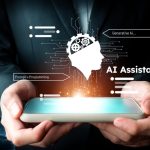Globalized Remote Work and Cloud Integration
AI-Augmented Globalized Remote Work and Cloud Integration: The New Frontier of Digital Productivity
In just a few short years, the way we work has undergone a seismic shift. What began as a reactive move to remote work during the COVID-19 pandemic has now transformed into a deliberate, strategic shift toward globalized, AI-augmented, and cloud-integrated work ecosystems.
As companies move toward decentralization, artificial intelligence (AI) and cloud technologies are becoming the pillars of this new, borderless workplace. Today’s blog explores how AI and cloud integration are revolutionizing the way global teams operate — from hiring and collaboration to security and productivity.
🌐 1. Globalized Remote Work: A Permanent Shift
Remote work is no longer a trend — it’s a foundation of the modern enterprise. Organizations are now designing operational models that transcend national boundaries, tapping into global talent pools to gain a competitive edge.
Key Drivers:
- Access to global talent: Companies can now hire the best talent regardless of geography.
- Cost efficiency: Hiring in diverse economic zones reduces overhead.
- Work-life balance: Flexibility has become a top priority for knowledge workers.
However, managing such a distributed workforce presents new challenges: misaligned time zones, regulatory compliance, fragmented communication, and cultural gaps. This is where cloud integration and AI step in.
☁️ 2. Cloud Integration: The Backbone of Borderless Work
The cloud is the connective tissue that allows remote teams to function seamlessly across geographies. It enables:
Unified communication platforms (e.g., Microsoft Teams, Zoom, Slack).
Real-time collaboration through tools like Google Workspace, Notion, and ClickUp.
Secure access to data via distributed cloud storage and virtual desktops.
By using cloud-native platforms, companies can build digital workspaces that mirror traditional office functions — but with far greater flexibility and resilience.
📌 Stat: According to a 2025 IDC report, 83% of global enterprises now operate in hybrid or fully remote environments powered by multi-cloud ecosystems.
🤖 3. AI-Augmented Productivity: Supercharging Global Teams
AI is now embedded into virtually every major productivity platform — not just as a backend algorithm, but as an active assistant in daily workflows. It helps:
Summarize meetings with tools like Zoom AI Companion or Otter.ai.
Translate languages in real time (Google Meet’s AI or Microsoft Teams).
Write, review, and organize content with tools like GrammarlyGO or Notion AI.
Automate workflows using GPT-based bots in Slack, Trello, and Asana.
Example:
Imagine a remote team spread across India, Germany, and Brazil. With AI:
Meeting notes are automatically transcribed and translated.
Action items are suggested in Slack post-meeting.
Language differences are bridged by real-time transcription and chat translation.
A cloud-based AI assistant drafts follow-up emails and schedules the next sync.
🧑💼 4. Managing a Global Workforce with Cloud HR and AI
Human Resource Management has transformed with cloud-based, AI-powered platforms like:
Deel, Remote.com, Oyster — for international payroll, contracts, and compliance.
Workday, SAP SuccessFactors, Rippling — for AI-powered hiring, onboarding, and performance management.
These platforms support:
- Automatic tax compliance across jurisdictions.
- AI-based matching of job candidates to open roles.
- Predictive analytics on retention and productivity.
- Support for digital nomads and hybrid workers.
This evolution empowers businesses to scale globally without building local entities — a game-changer for startups and SMEs.
🔐 5. Securing Remote Work: AI and Zero Trust Cloud Security
Security is one of the biggest concerns in global remote operations. AI and cloud services are evolving rapidly to counter new threats through:
Zero Trust Architecture: Every access request is authenticated and verified.
AI-driven threat detection: Systems analyze behavioral patterns and flag anomalies.
Cloud compliance automation: Tools help enforce GDPR, HIPAA, and India’s DPDP Act policies across borders.
Cybersecurity tools now include:
- Microsoft Defender for Cloud.
- Cisco SecureX.
- CrowdStrike Falcon with AI-enhanced monitoring.
🧠 6. The Future: Virtual-First and AI-Native Workforces
We are entering the age of cloud-native, virtual-first companies. These businesses:
Have no central office.
Operate across time zones with async work models.
Use digital HQs like Gather or Meta Horizon Workrooms.
Employ AI teammates (e.g., meeting bots, writing copilots, data analysts).
Additionally, edge cloud computing will allow professionals — including digital nomads — to work from remote or rural areas with low-latency access to cloud tools.
Trends to Watch:
- AI coworkers as integral members of teams.
- Smart scheduling that optimizes across multiple calendars and zones.
- AI-generated content and design for marketing and internal documentation.
🌍 Conclusion: Welcome to the AI-Cloud Remote Work Era
AI and cloud integration aren’t just technologies — they are transformative enablers of the global workforce. Businesses that adopt AI-augmented workflows and cloud-native infrastructures are not just future-proofing their operations — they are redefining work itself.
Remote work will continue to evolve, but the winners will be those who invest in secure, intelligent, and borderless systems. From talent acquisition to daily task management, the AI-powered cloud is the new office.
✅ Key Takeaways:
Cloud integration provides scalable infrastructure for global remote work.
AI tools increase efficiency, reduce language barriers, and automate repetitive tasks.
Cloud HR platforms make managing international talent seamless and compliant.
AI-enhanced cybersecurity ensures safe, distributed operations.
Virtual-first companies are thriving in the cloud-AI era.
📣 Call to Action
Is your organization ready for the next wave of remote work?
📧 Contact our digital transformation team for a consultation.
📰 Subscribe to our newsletter for more insights on AI, cloud, and the future of work.





